#Mark Molnar
Explore tagged Tumblr posts
Text

Venerable Pardis
by Mark Molnar
#imperium#space marines#loyalist astartes#deathwatch#other chapters#dreadnought#warhammer#warhammer 40k#warhammer 40000#40k#mark molnar
197 notes
·
View notes
Text

Star Wars: X-Wing - Imperial Veterans Expansion Pack - Maarek Stele, TIE Defender by Mark Molnar
#Star Wars#Star Wars: X-Wing#Imperial Veterans Expansion#Maarek Stele#TIE Defender#Galactic Empire#Imperial#Starfighter#Sci-Fi#Mecha#Spaceship#FFG#Fantasy Flight Games#Mark Molnar
92 notes
·
View notes
Text

The Emperor's Arrival by Mark Molnar
103 notes
·
View notes
Text

TIE Defender
by Mark Molnar
#star wars#star wars art#tie fighter#tie defender#galactic empire#star wars spaceships#starship#star fighter
182 notes
·
View notes
Text
Paludirex: Life of the Swamp King
Having gotten the long taxonomic history of Pallimnarchus and Paludirex out of the way (see here), lets talk more about the animal itself.
As far as we know at this point in time, Paludirex was the last of the large semi-aquatic mekosuchines and the largest members of this group had ever gotten. Whereas the cleaver-headed Baru dominated the waterways of the Oligocene and Miocene, Paludirex lived from the Pliocene and Pleistocene. There is some division between the species tho as it appears. Given the ambiguity around the origin of some Paludirex vincenti specimens, this species is currently only known from the Pliocene, whereas Paludirex gracilis is currently only known from the Pleistocene. There may also be a third species from the same region as Paludirex vincenti.
Comparisson between Paludirex gracilis (left) and Paludirex vincenti (right)

Anatomically, Paludirex has a pretty easily recognizable animal. Unlike Baru, with its short, triangular skull, Paludirex had a head that was almost rectangular when viewed from above, about half as wide as long and comparably flat. Mind you the skull can still be pretty deep, especially in Paludirex vincenti, but the proportions still highlight how wide it is most of all. In both robustness and skull width, Paludirex far exceeds what is known in modern saltwater crocodiles, which likely fill a similar niche.
Left: Skull reconstruction of Paludirex vincenti. Right: Life reconstruction of Paludirex (Nellie Pease)
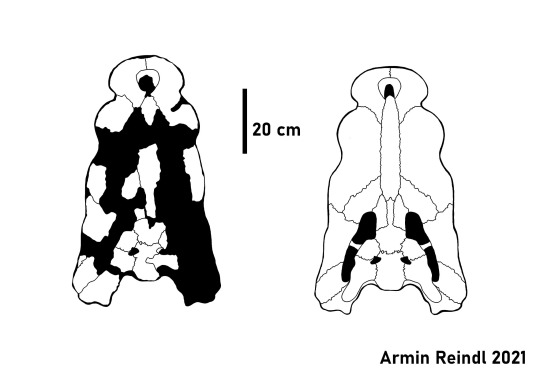

As said before, Paludirex represents the biggest mekosuchine. At a minimum length of 4 meters, it already rivals many of today's crocodiles and Baru, and that's just the smaller ones. Large individuals of Paludirex vincenti probably got much larger, 5 meters and more further drawing parallels to todays salties.
A size comparisson between Steve Irwin and both species of Paludirex
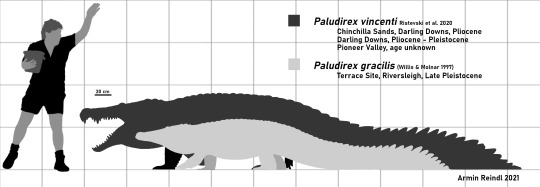
Now while the description is pretty sound on account of recent work by Ristevski and co., the ecology is a different matter. A lot of work was published back when Pallimnarchus was still a thing, so trying to separate what and what isn't applicable these days is a bit of a challenge.
On the most simple level, Paludirex was a generalist semi-aquatic ambush hunter. It's skull, tho incredibly robust and wide, shows no peculiar adaptations like long slender jaws so its obviously not a specialist. It's semi-aquatic because the nostrils and eyes face up so that they would peer out from the water while the rest of the body remained submerged. And these last two together basically suggest ambush-hunting.
Willis and Molnar also made comparissons between Paludirex skulls (or rather skulls now recognized as such) and Mugger crocodiles. All in all this suggests that its diet could have ranged from turtles to aquatic birds to large mammals (so the typical croc range really). They also infer that it may have had similar habitat preferences, being found in marshes, swamps, rivers, lakes, anywhere theres freshwater really. One exception may be that some researchers have argued that Paludirex was avoiding saltwater and brackish water, which eventually could have factored into its extinction once inland waterways in Queensland dissappeared.
Top: Eastern Sahul megafauna, the foreground features Paludirex about to ambush a giant kangaroo (Ryan Bargiel, Vlad Konstantinov, Andrey Atuchin & Scott Hocknull) Bottom left: Paludirex vincenti (Diego Ortega Anatol) Bottom right: An unforunate Paludirex being attacked by a marsupial lion (Joschua Knüppe)

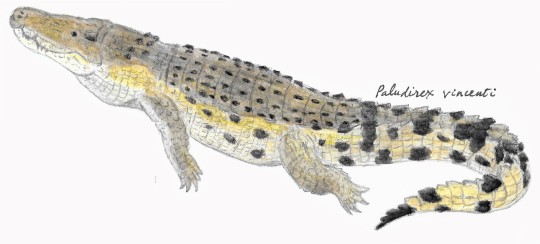

As with many crocs, its pretty likely that individuals were hostile towards each other at certain times, perhaps during territorial disputes or in the mating season. Now this one's a bit of a more ambiguous one regarding the assignment of the fossils. Fossils of leg material show clear bite marks, HOWEVER, the fossils were assigned to Pallimnarchus purely on the basis that they don't appear to have belonged to a terrestrial animal (as often inferred for Quinkana) nor to a modern croc. Based on this, the material was assumed to have been that of Pallimnarchus without much else to back it up. Now that Pallimnarchus is no more, it is reasonable to assume that it may be Paludirex but then again, it could also be an entirely different animal. Only way to tell would be to find Paludirex fossils with leg fossils attached.
This does bring up the interesting discussion, what crocs did coexist with Paludirex? Well there's a couple. As just mentioned, there's Quinkana, which I'll research more in depth later, but for now it's commonly assumed to be more terrestrial than other mekosuchines. There's the Darling Downs form, which lived around the same time as Paludirex vincenti in Queensland and may be a third species of this taxon. Gunggamarandu is another animal from this region, tho much as with Paludirex its not entirely clear if its Pliocene or Pleistocene. More certain is the fact that during the Pleiostocene, Paludirex gracilis coexisted with freshwater crocodiles in the Riversleigh WHA. Finally, there's indetermined species of crocodiles that date as far back as the Pliocene. Historically, they've been regarded as salties, but more recently it's though that they were a different species entirely and that salties only moved in recently, possibly after Paludirex went extinct and the niche of large semi-aquatic predator was free.
Top left: Quinkana faces off against Megalania (Hodari Nundu) Top right: A freshwater crocodile running (Brandon Sideleau) Bottom: Gunggamarandu, a relative of today's gharials (Eleanor Pease)


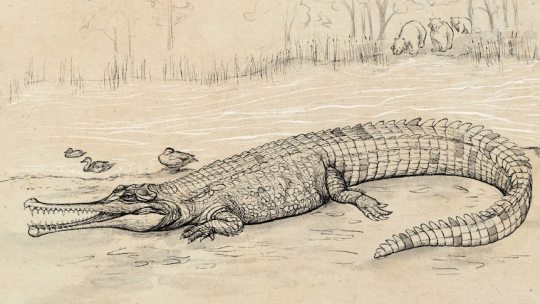
By this point I've basically already given away the reason why Paludirex is no more. With mekosuchines already taking a massive hit during the late Miocene, the group was not at its peak when Paludirex came around. And things were not getting any better as Australia grew more and more arid, river systems disappearing, freshwater drying up and the habitat of these animals shrinking bit by bit. Paludirex, presumably staying clear of coastal waters, was hit hard by these events and eventually it was just too much. And once it was out, saltwater crocodiles moved in, leading into the modern day.
#paludirex#pallimnarchus#palaeoblr#pliocene#pleistocene#australia#paleontology#prehistory#crocodile#croc#crocodilia#mekosuchinae#gunggamarandu#paludirex vincenti#paludirex gracilis#quinkana
119 notes
·
View notes
Text

Artwork for Star Wars LCG: Galactic Ambitions by Mark Molnar
15 notes
·
View notes
Text

by Mark Molnar
18 notes
·
View notes
Text

If you’re in Montreal this Wednesday (March 13, 2024 at 19:30) you should definitely go see Like Eagles at La Chapelle Scènes Contemporaines:
https://levivier.ca/en/concert/2023-24-season/eagles
Facebook event.
A re-creation and multimedia conception of the film Like Eagles (Mānand-e ‘Oqāb).
In this performance, playwright/librettist Shaista Latif, composer Osama Shalabi, arranger Isak Goldschneider and the Land of Kush ensemble imagine a multimedia re-creation and conceptualization of Like Eagles (Mānand-e ‘Oqāb): the first feature film produced in Afghanistan. An exquisitely surreal vision of Kabul in the 1960s, it follows a young girl as she wanders through the city on a journey from her hometown to attend a day of national celebration.
In light of subsequent tragic events in Afghan history, the project confronts Western stereotypes of Afghanistan in a stage work combining music, text and film.
Performers: Shaista Latif (actor/director/writer) Osama Shalabi (oud and electric guitar) Isak Goldschneider (clarinet) Adrianne Munden-Dixon (violin) Anna Atkinson & Gen Heistek (violas) Mark Molnar (cello)
Presented as part of La Semaine du Neuf Festival in collaboration with Groupe Le Vivier.
3 notes
·
View notes
Photo

The Alienist by artist Mark Molnar via ImaginaryCityscapes
12 notes
·
View notes
Text
i was tagged by @summersizedmii thx babe
Rules: List ten books that have stayed with you in some way, don’t take but a few minutes, and don’t think too hard - they don’t have to be the “right” or “great” works, just the ones that have touched you.
so i followed the tenet that i still need to be thinking of these books now & once i ran out of books i think of constantly, i added ones that touched me to the point i claimed them as mine
Deity by Matt Wesolowski. according to my goodreads review i didnt like this super much but its just stuck in my mind cause of the horror themes interweaved with celebrity-fan culture
House of Leaves by Mark Z. Danielewsky. simply transformative nothing else to say
A Monster Calls by Patrick Ness. may have read this one at 20 yos but i was bawling in the living room
Paul Street Boys by Ferenc Molnar. read this one in primary school but i was so struck that i spent half an hour sobbing in my moms lap (as did many of the girls as it turned out lol)
Perfume: The Story of a Murderer by Patrick Süskind. read it when i was 16 & was changed forever. maybe the primary reason behind me looking into cannibalism sm lol
Kokoro by Natsume Soseki. grrr it was just very intriguing & a slow look into two mens lives
Scum Villain's Self-Saving System by Mo Xiang Tong Xiu. okay so i didnt like it that much while reading but it was this silly trashy series that i still think of due to the reader-insert
Medea by Euripides. women committing wrongs #feminism
When We Were Animals by Joshua Gaylord. smth in me just claimed this book. it was dark it was weird teens were bad here no one else i knew had read this one
no one look at me naming 3 different books for the last one but Freshwater by Akwaeke Emezi. absolutely breathtaking depiction of one's inner mind & gender; Clockwork Orange by Anthony Burgess. i read the edition with all the originally excluded slang added so as a linguistics student who had also taken russian for like 6-7 years it was a joy; Revenge by Yoko Ogawa. yeah i keep thinking of the writing style truly an inspiration to me
tagging 0 people but anyone who'd like can do this <3
5 notes
·
View notes
Text
National Fossil: Panama
The columbian mammoths have won in Mexico!
The fossil record for many Central American countries is a bit scarce, so I‘m gonna skip over to Panama, while I think about what to do with the other countries.
Once again, you get to vote on which fossil should represent the nation. As always, it could be a fossil that is just exceptionally well preserved and beautiful, had a huge impact on paleontology and our knowledge of the past, is very common/representative of the area, is beloved and famous in the public eye, is just a very unique and interesting find, or has any other justification.
Here are your options:

Panamacebus: Our first (and very fittingly named) candidate is only known from a couple of teeth, but they are very important teeth, as they mark the oldest known instance of South American animals making it over to North America (the two continents used to be divided by sea). The capuchin like monkey lived 20 million years ago, more than 10 million years before the next known case of this migration happened

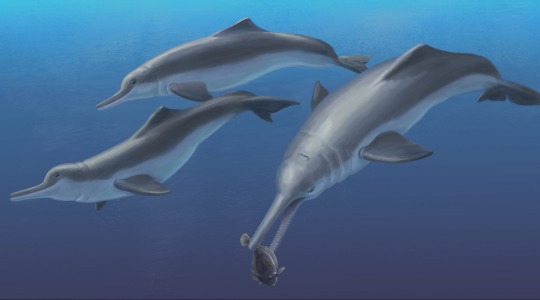
Isthminia: Named after the Isthmus of Panama the river dolphin was a relative to modern Amazon river dolphins (Art by Julia Molnar)
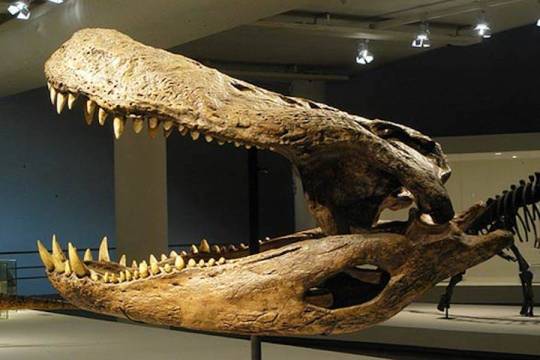
Purussaurus: It is a giant crocodile with size estimates upwards of 10 m, what else do I need to say? They lived during the Miocene in South America, but were also found in Panama

Mixotoxodon: Only known from fragmentary remains, but this is the only one of the South American Native Ungulates (a weird brand of ungulates not related to any of the other ones we have today) that made it into Central America once the two landmasses connected (Art by Bran-Artworks)


Scelidotherium: I have to give some ground sloth representation! This one looks almost like an ant-eater and was found in South America and also Panama (Art by Martina Chernelli)

Cuvieronius: This one is from an originally North American animal group, the gomphotheres (related to elephants). Cuvieronius was among the last of its kind only becoming extinct at the end of the Pleistocene. Their range extended all the way from the southern US through Central America and into South America
#paleontology#paleoblr#fossils#panamacebus#isthminia#purussaurus#mixotoxodon#scelidotherium#cuvieronius
4 notes
·
View notes
Text



50) Modern Age - amerykański konserwatywny kwartalnik akademicki, założony w 1957 r. przez Russella Kirka w ścisłej współpracy z Henrym Regnerym. Pierwotnie wydawany niezależnie w Chicago, w 1976 r. został przeniesiony na Intercollegiate Studies Institute.
Zakładając pismo, Kirk miał nadzieję na „godne forum dla refleksyjnego, tradycjonalistycznego konserwatyzmu”, a czasopismo pozostało jednym z głosów intelektualnego, pisanego z małej litery konserwatyzmu do dnia dzisiejszego. Odzwierciedlając ideały swojego założyciela, w swojej polityce jest tradycjonalistyczne, lokalne, przeciwne większości interwencji wojskowych, nielibertariańskie, antystraussowskie i ogólnie krytyczne wobec neokonserwatyzmu. W swoich sympatiach religijnych trzyma się ortodoksji, czy to rzymskokatolickiej, żydowskiej, prawosławnej czy protestanckiej. Modern Age został opisany przez historyka George'a H. Nasha jako „główny kwartalnik intelektualnej prawicy”. Paul Gottfried, profesor w Elizabethtown College w Pensylwanii, powiedział, że „Modern Age reprezentuje humanistyczną naukę, szacunek dla wieczności i poczucie ludzkiej skończoności, wartości, które (niestety) mają coraz mniej wspólnego z akademicką prezentacją sztuk wyzwolonych”. Kirk redagował publikację od 1957 do 1959 roku. Eugene Davidson redagował ją od 1960 do 1969 roku. David S. Collier był trzecim redaktorem kwartalnika od 1970 do 1983 roku. Czwartym redaktorem Modern Age był George A. Panichas, który pełnił tę funkcję od 1984 do 2007 roku. Następnym redaktorem był R. V. Young. Peter Lawler zastąpił Younga w 2017 r. Lawler zmarł później w 2017 r. i zastąpił go obecny redaktor, Daniel McCarthy.
Redaktorem wykonawczym czasopisma jest Mark Henrie, redaktorem zarządzającym jest Arthur Bloom, a redaktorem poezji jest James Matthew Wilson. Redaktorami pomocniczymi są George W. Carey, Jude P. Dougherty, Jeffrey Hart, Marion Montgomery, Mordecai Roshwald i Stephen J. Tonsor.
Do grona autorów magazynu Modern Age należą:
Paul Gottfried
Jeffrey Hart
Paul Hollander
Irving Louis Horowitz
Carol Iannone
Russell Kirk
E. Christian Kopff
W. Julian Korab-Karpowicz
Peter Lawler
Thomas Molnar
Revilo P. Oliver
Mordecai Roshwald
Claes G. Ryn
Ellis Sandoz
R. J. Stove
R. V. Young.
0 notes
Text




#REPOST @/pixoloidstudios
Conceito de keyframe para Entrevista com o Vampiro s2
Artistas: Mark Molnar, Janos Gardos
#samreid #samreidbrasil #interviewwiththevampire #entrevistacomovampiro
#conceptart #keyframes
0 notes
Text

TIE Fighters
by Mark Molnar
176 notes
·
View notes
Text
Oh, poor Springfield, OH.
The story about the pets being eaten has a couple of germs: someone in Canton, OH was arrested for stomping a cat to death, while a woman in Springfield posted a fake story on Facebook about a cat being killed and hung from a tree. Then the Neo-Nazis got involved and everything went to hell, complete with "the great replacement theory" and bomb threats.
CantonRep.com's Nancy Molnar wrote about an incident in August of this year, when a woman was arrested after stomping a cat dead and (maybe?) eating part of it. The same woman was also arrested over 10 years ago and is not Haitian, and, y'know, she's in Canton (which is more than 140 miles away on the other side of the state).
The Haitians in Springfield were offered work permits and Temporary Protected Status because of the years-long strife in their island home country. Springfield's local Dole plant and an auto parts company both wanted for labor post-Covid lock-down, and the Haitians had been "trickling in" since 2017 -- so they seemed a likely population to invite in larger numbers. Essentially: factories needed workers, Haitians wanted to work, Springfield worked to make that happen.
As The Guardian's Stephen Starr writes, "the glut of new arrivals has also stretched hospitals and schools in the area, angering many locals who resented their presence. The outrage reached a crescendo last August, when an 11-year-old boy was thrown from a school bus and killed after its driver swerved to avoid an oncoming car driven by a Haitian immigrant ...Soon, rightwing extremists seized on Springfield’s unrest.
Armed neo-Nazi members of Blood Tribe...flew flags bearing swastikas and marched through a prominent downtown street while a jazz and blues festival was taking place nearby in August." Plus other asinine neo-Nazi stuff.
Then after the debates came the bomb threats. As Edward Helmore writes: "Two hospitals in Springfield, Ohio, were sent into lockdown after bomb threats, police said on Saturday, marking the fourth such case in as many days that appears linked to false claims circulating among the far right that Haitian immigrants there are eating domestic pets and wildlife."
Evacuations, searches (no bombs -- so far), frayed nerves, Haitians staying behind closed doors, Black Americans being threatened on the streets (apparently they look Haitian?) and then Helmore relates this convoluted tale:
"On Friday, a Springfield woman, Erika Lee, apologized for rumors about Haitian immigrants eating pets that resulted from a post she wrote on Facebook claiming that the friend of a neighbor’s daughter lost her cat – and then found the animal strung up outside the home of a Haitian family.
Lee now says she had no firsthand knowledge of the claim. The neighbor referenced in the post, Kimberly Newton, revealed that she also had heard the story from an acquaintance and not her daughter.
Lee said she was filled with regret and insists she never intended to put a target on the backs of the Haitian community.
'It just exploded into something I didn’t mean to happen,' Lee told NBC News on Friday."
And there may be the man in Columbus, OH, who was getting injured geese out of a roadway in that city who may have been misidentified as a hungry Haitian -- but anyway.
Plus, just icing on the cake, J.D. Vance says he just makes shit up to make a good campaign trail story!
"In a stunning admission, the Republican vice-presidential candidate, JD Vance, said he was willing 'to create stories' on the campaign trail while defending his spreading false, racist rumors of pets being abducted and eaten in a town in his home state of Ohio.
Vance’s remarks came during an appearance on Sunday on CNN’s State of the Union, where he said he felt the need 'to create stories so that the … media actually pays attention to the suffering of the American people'" as Helmore writes in a separate story.
Seems to me there are plenty of ways to highlight American people suffering that doesn't require making up shit about legal workers eating pets, but once the rumor mill starts churning, why not just keep it going?
0 notes
